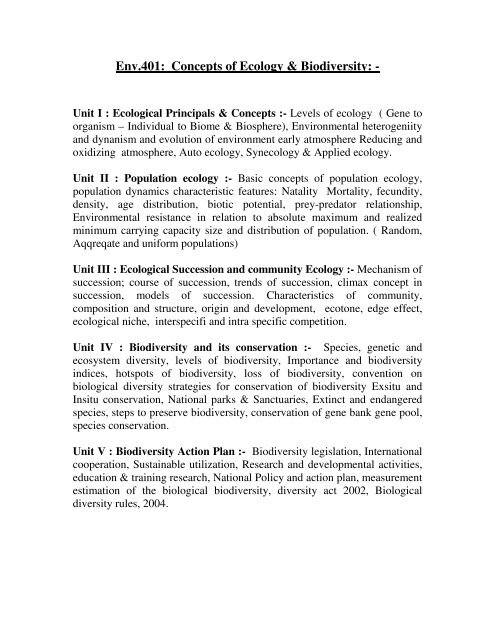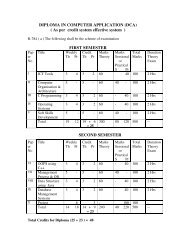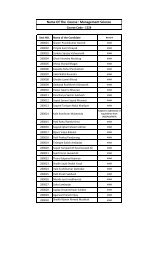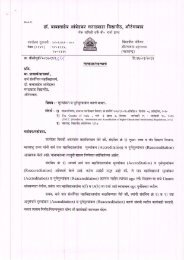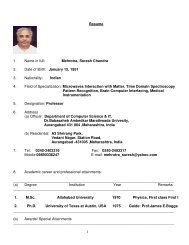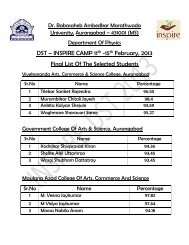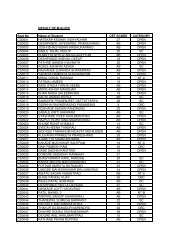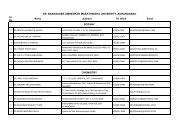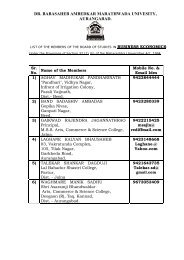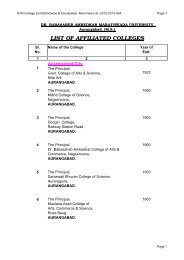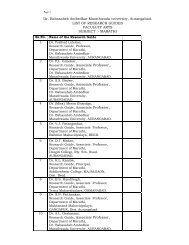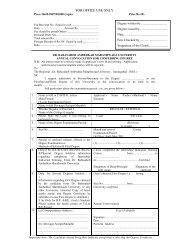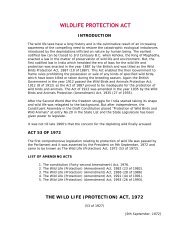Env.401: Concepts of Ecology & Biodiversity: -
Env.401: Concepts of Ecology & Biodiversity: -
Env.401: Concepts of Ecology & Biodiversity: -
You also want an ePaper? Increase the reach of your titles
YUMPU automatically turns print PDFs into web optimized ePapers that Google loves.
<strong>Env.401</strong>: <strong>Concepts</strong> <strong>of</strong> <strong>Ecology</strong> & <strong>Biodiversity</strong>: -<br />
Unit I : Ecological Principals & <strong>Concepts</strong> :- Levels <strong>of</strong> ecology ( Gene to<br />
organism – Individual to Biome & Biosphere), Environmental heterogeniity<br />
and dynanism and evolution <strong>of</strong> environment early atmosphere Reducing and<br />
oxidizing atmosphere, Auto ecology, Synecology & Applied ecology.<br />
Unit II : Population ecology :- Basic concepts <strong>of</strong> population ecology,<br />
population dynamics characteristic features: Natality Mortality, fecundity,<br />
density, age distribution, biotic potential, prey-predator relationship,<br />
Environmental resistance in relation to absolute maximum and realized<br />
minimum carrying capacity size and distribution <strong>of</strong> population. ( Random,<br />
Aqqreqate and uniform populations)<br />
Unit III : Ecological Succession and community <strong>Ecology</strong> :- Mechanism <strong>of</strong><br />
succession; course <strong>of</strong> succession, trends <strong>of</strong> succession, climax concept in<br />
succession, models <strong>of</strong> succession. Characteristics <strong>of</strong> community,<br />
composition and structure, origin and development, ecotone, edge effect,<br />
ecological niche, interspecifi and intra specific competition.<br />
Unit IV : <strong>Biodiversity</strong> and its conservation :- Species, genetic and<br />
ecosystem diversity, levels <strong>of</strong> biodiversity, Importance and biodiversity<br />
indices, hotspots <strong>of</strong> biodiversity, loss <strong>of</strong> biodiversity, convention on<br />
biological diversity strategies for conservation <strong>of</strong> biodiversity Exsitu and<br />
Insitu conservation, National parks & Sanctuaries, Extinct and endangered<br />
species, steps to preserve biodiversity, conservation <strong>of</strong> gene bank gene pool,<br />
species conservation.<br />
Unit V : <strong>Biodiversity</strong> Action Plan :- <strong>Biodiversity</strong> legislation, International<br />
cooperation, Sustainable utilization, Research and developmental activities,<br />
education & training research, National Policy and action plan, measurement<br />
estimation <strong>of</strong> the biological biodiversity, diversity act 2002, Biological<br />
diversity rules, 2004.
402 Climatology and Ecodynamics :-<br />
Unit I : Climate :- Weather, Climate, Major Climatic regions <strong>of</strong> the world<br />
based on latitude, with distribution <strong>of</strong> vegetation, classification <strong>of</strong> climates<br />
criteria for classification. Thornthwaites and koppens classifications,<br />
climatogram studies. El-Nino effect.<br />
Unit II : Meteorology :- Scale <strong>of</strong> meteorology, pressure, temperature,<br />
adiabatic lapse rates, atmospheric stability, wind velocity, wind roses and<br />
turbulence plume behaviour various types <strong>of</strong> plumes and dispersion models<br />
<strong>of</strong> air Weather forecasting Basic numerical modeling approach –Guassion<br />
plume model Emission inventory.<br />
Unit III : Monitoring <strong>of</strong> air quality :- Establishing ambient and emission<br />
standards, ambient air sampling methods for collection and analysis <strong>of</strong><br />
suspended particulate matter, ( SPM), Respirable suspended particulate<br />
matter ( RSPM) sulphur dioxide (SO2) and oxides <strong>of</strong> nitrogen (No),<br />
oxidants carbon, monoxide ( CO) and hydrocarbons ( HC) stack sampling &<br />
analysis <strong>of</strong> spm, Rspm, So2 No2 etc.<br />
Unit IV : Ecosystem dynamics and biomass productivity :- Definition,<br />
kinds <strong>of</strong> ecosystems, fundamental concepts, biotic and abiotic components<br />
and their functions, nutrient pool, energy flow through ecosystems :<br />
Ecological energeties, food chains, food web, Trophic levels, ecological<br />
pyramids.<br />
- <strong>Concepts</strong> <strong>of</strong> biomass, Biomass utilization<br />
- Productivity, types <strong>of</strong> productivity<br />
Methods <strong>of</strong> measurement <strong>of</strong> biomass and productivity, Ecological<br />
efficiencies.<br />
Unit V : Energy resources Management :- Sources <strong>of</strong> energy, Energy<br />
requirement, conventional energy system - wood, Coal hydro and thermal<br />
power energy, Non-conventional energy systems- Bioenergy, biogas energy.<br />
Ocean & tidal energy. Nuclear energy, solar energy, wind energy geothermal<br />
energy, energy from wastes Eco technology sustainable development.<br />
Photovoltaics, solar ponds. Energy from biomass, biogas, anaerobic<br />
digestion; energy use pattern in different parts <strong>of</strong> the world.
Env. 403 Environmental Chemistry and Geoscience<br />
Unit I :- Fundamentals <strong>of</strong> Environmental Chemistry :- Stochiometry,<br />
Gibb’s energy, chemical potential, chemical equilibria, acid base reactions,<br />
solubility Product, solubility <strong>of</strong> gases in water, the carbonate system<br />
unsaturated and saturated hydrocarbons.<br />
Unit II : Global Warming :- Chemistry <strong>of</strong> green house gases, emission <strong>of</strong><br />
Co2, consequences <strong>of</strong> green house gases, control & remedial measures,<br />
global warming a serious threat. Earth radiation balance & heat islands.<br />
Chemistry <strong>of</strong> ozone layer formation <strong>of</strong> ozone, depletion <strong>of</strong> ozone layer,-<br />
mechanism <strong>of</strong> ozone depletion, its effect & protection measures. Formation<br />
<strong>of</strong> acid-rain & its effects. Chemistry <strong>of</strong> photochemical smog, O3, Nox, HC<br />
CFCS & PAN. Thermo chemical and photo chemical reaction in the<br />
atmosphere .<br />
Unit III: Chemistry <strong>of</strong> Industrial Pollutants:- Classification <strong>of</strong> Industrial<br />
Pollutants, Chemical characteristics <strong>of</strong> waste water, heavy metals, soaps &<br />
detergents, polymers & plastics, asbestos & food additives, fertilizers,<br />
insecticides, fungicides, herbicides chemistry <strong>of</strong> pollutants from pulp &<br />
paper mill, sugar & starch industries, textile, cement & pharmaceutical<br />
industries. Destruction <strong>of</strong> hazardous substances – Acid halides – and<br />
anhydrides, alkali metals, cyanides and cynogen bromides, chromium,<br />
aflatoxins, halogented compounds<br />
Unit IV : Geo-environment :- Introduction, Environmental dilemmas,<br />
fundamental concept <strong>of</strong> environmental geology. The concept <strong>of</strong> earth<br />
system, cycles in earth system- The energy cycle ( energy inputs, solar<br />
radiations, geothermal energy, tidal-energy). Earth’s thermal environment<br />
and seasons. Indian monsoon, El-nino; The rock cyeles (heat transfer in the<br />
earth, plate tectonics and earth’s external structure,) droughts, tropical<br />
cyclones & western disturbances.<br />
Unit V : Geological hazards :- Assessing geologic hazards & risks, types <strong>of</strong><br />
hazards, earth quakes, volcanic eruptions, floods, subsidence, landslides,<br />
hazards <strong>of</strong> ocean & weather. Environmental impacts <strong>of</strong> mining, mining for<br />
ground water, sea water intrusion, surface blasting etc.<br />
* Current developments in the subject
Env. 404 : Environmental Instrumentation and Analytical Methods.<br />
Unit I : Sampling :- Sample preparation, methods <strong>of</strong> sample pre - treatment,<br />
standard calibration, sample classification by size and analyses level, limits<br />
<strong>of</strong> trace analysis, preservation, storage and processing <strong>of</strong> air, liquid ( Water)<br />
and Solid (Soil) samples, Separation and sampling techniques- precipitation,<br />
fractional crystallization, fractional distillation, solvent extrgaction etc.<br />
Unit II : Potentiometer :- Determination <strong>of</strong> concentration from potential<br />
measurement ion selective electrodes – NH4 + Cl - , F, H + , Na + , turbidity<br />
meter, & Nephelometer , fluorometer etc.<br />
Unit III : Colorimetry and Spectrophotometry :- Types <strong>of</strong> colorimeter,<br />
Types <strong>of</strong> spectrophotometers ( UV, IR. & NMR), flame emission, flame<br />
absorption Atomic Absorption Spectrophotometer (AAS) etc.<br />
Unit IV : Chromatography :- Principals, methods & applications <strong>of</strong> thin<br />
layer chromatography ( TLC), Gas chromatography ( GC), column<br />
chromatography, Gas- liquid chromatography ( GLC) high performance<br />
liquid chromatography ( HPLC) Ion exchange chromatography etc.<br />
Unit V : Electrophoresis :- Theory & applications pH meter, High volume<br />
air sampler, (HVAS), Repairable dust particulate matter sampler (Rspm),<br />
suspended particulate matter sampler ( spm), Anderson/Tilak air sampler for<br />
biomonitoring.<br />
* Current development in the Subject:-
Env. 405 : Bioinformatics and Environmental System Analysis<br />
:-<br />
Unit I : Biostatistics :- Introduction to statiscs population, sample primary<br />
and secondary data- collection <strong>of</strong> primary data graphical and diagrammatic<br />
representation <strong>of</strong> data-Measures <strong>of</strong> central tendency mean, median and<br />
mode. Measures <strong>of</strong> dispersion range, standard deviation, raw and central<br />
moments, skewness and kurtosis (definitions only). Concept <strong>of</strong> probability<br />
classical and relative frequency definitions <strong>of</strong> probability. Addition and<br />
multiplication laws <strong>of</strong> probability and examples.<br />
Unit II : Concept <strong>of</strong> random variable, probability mass function, probability<br />
density function, and probability distribution function (definitions only).<br />
Binomial, Poisson and normal distribution ( definitions and statements <strong>of</strong><br />
properties) examples.<br />
Principle <strong>of</strong> teast squares- fitting <strong>of</strong> straight l.n.e. persons coefficient<br />
<strong>of</strong> correlation and statement <strong>of</strong> its properties and examples. Concept <strong>of</strong><br />
simple linear regression-examples.<br />
Unit III : Test <strong>of</strong> Significance :- Concept <strong>of</strong> simple random sampling and<br />
stratified random sampling concept <strong>of</strong> testing <strong>of</strong> hypothesis critieal region-<br />
two types <strong>of</strong> errors, level <strong>of</strong> significance, large sample tests for single mean<br />
and difference <strong>of</strong> means, single proportion and difference <strong>of</strong> proportion.<br />
Chisquare test for goodness <strong>of</strong> fit and for independence <strong>of</strong> attributes,<br />
students is t- test for single mean and difference <strong>of</strong> means and Ftest for<br />
equality <strong>of</strong> variances. Concept <strong>of</strong> ANOVA-examples on one way and two<br />
way classifications.<br />
Unit IV : Environmental System analysis and modeling :- Approaches to<br />
development <strong>of</strong> models, linear, simple and multiple regression models,<br />
validation and forecasting models, population growth and interaction model<br />
Lotka voltrra model, Leslie’s matrix model, point sources stream pollution<br />
model, box model, Gauss ion plume model.<br />
Unit V: Computer Programming: - Computer organization, computer<br />
generation and classifications, structure, function, capabilities and<br />
limitations <strong>of</strong> computers, computer packages, DOS, MS-Office (MS Word,<br />
MS PowerPoint, MS-Excel) for data input & output Development <strong>of</strong>
different environmental models by simple computer programming. Internet<br />
access to generate the environmental data.<br />
* Current development in the subject :-<br />
Env. 406 : Environmental Microbiology and Disease Control<br />
Management<br />
Unit I : Microorganisms and the Environment :- Microorganisms and the<br />
structure <strong>of</strong> ecosystems. The physiological state <strong>of</strong> microorganisms in<br />
Ecosystems. Microbiology <strong>of</strong> extreme environments. Surfaces & Bi<strong>of</strong>ilms ,<br />
Microbial mats. Pure culture concept. Techniques used for environment <strong>of</strong><br />
culture concept. Techniques used for environment <strong>of</strong> culture. Method <strong>of</strong><br />
pure culture, preparation, maintenance and preservation <strong>of</strong> microbial culture,<br />
types <strong>of</strong> culture, sterilization and disinfections. The influence <strong>of</strong><br />
environmental factors on growth.<br />
Unit II : Microbiology <strong>of</strong> Air , Water & Soil :- Distribution <strong>of</strong> microbes<br />
in air, Allergic disorders by air micr<strong>of</strong>lora fungal and pollen allergens.<br />
Collection and enumeration <strong>of</strong> aeroallergens. The microbial community in<br />
Marine and Fresh water environments. Aquatic nutrient cycles - Carbon,<br />
Nitrogen, Phosphorus & Sulpher, Bacteriological analysis <strong>of</strong> water. Sewage<br />
and waste water microbiology biodegradation <strong>of</strong> Industrial wastes<br />
Microbiology <strong>of</strong> soil – soil habitats, microbial biogeochemical cycling.<br />
Nutritional types <strong>of</strong> organisms. Nitrogen fixation.<br />
Unit III : Microbiology <strong>of</strong> food :- Microorganisms and food spoilage.<br />
Microbial examinations <strong>of</strong> food. Food processing and methods <strong>of</strong><br />
preservation . Preservation alternatives. Microbial examination <strong>of</strong> milk &<br />
dairy products. Important fermented food. Disease and foods.<br />
Microorganisms as sources <strong>of</strong> food. Control <strong>of</strong> microorganisms by physical<br />
and chemical agents.<br />
Unit IV : Industrial Applications <strong>of</strong> microorganisms.:- Role <strong>of</strong><br />
microorganisms in the production process <strong>of</strong> products medicines<br />
(Pharmaceuticals) organic acids, amino acids, Enzymes, fuels, Alcoholic<br />
beverages, Enhanced recovery <strong>of</strong> metals, petroleum products.
Unit V : Infection and Disease :- Transmission <strong>of</strong> disease, types <strong>of</strong><br />
diseases, Establishment <strong>of</strong> disease, resistance to disease. Immune disorders<br />
bacterial diseases <strong>of</strong> man, viral disease <strong>of</strong> man. Control <strong>of</strong> microorganisms<br />
by physical and chemical agents.<br />
* Current development in the subject:-<br />
Env. 407: Advance In Pollution Control Technology:<br />
Unit I : Air Pollution Control Methods :- Need for control methods.<br />
Particulate emission controlgravitational settling chambers cyclone<br />
separaters fabric filters Electrostatic precipitators wet scrubbers. Control <strong>of</strong><br />
gaseous pollutants – So2, No x , Co, Co2 PAN & Hydrocarbons modifications<br />
<strong>of</strong> operating conditions. Modification <strong>of</strong> design conditions. Automobile<br />
pollution control - control at sourcefuel tank, carburetor, crankcase Exhaust<br />
emissions Indian scenario.<br />
Unit II : Sewage and Industrial Waste Water Treatment :- The need for<br />
waste water treatment: Treatment <strong>of</strong> waste water – Primary treatment<br />
(Sewage)-screens, grit chambers and oil separation & primary sedimentation<br />
primary treatment (industrial waste water) – segregation, equalization,<br />
neutralization, sedimentation, flotation & Oil separation.<br />
Secondary treatment : principal <strong>of</strong> biological treatment – waste stabilization<br />
ponds – Aerated lagoon, - Activated sludge process- trickling filters, Sludge<br />
treatment and disposal, preliminary operations- sludge thicker-sludge<br />
digesters, sludge conditioning- dewatering methods – sludge drying beds,<br />
vacuum filtration – filter process, centrifugation – sludge disposal methods.<br />
Unit III : Advanced waste water treatment :- Removal <strong>of</strong> suspended<br />
solid, dissolved solidsnitrogen removal-phosphorous removal - Adsorptionrefractory<br />
organics and their treatment – Reuse and recycle <strong>of</strong> waste water.<br />
Operation, monitoring & designig <strong>of</strong> Effhient treatment plants including<br />
preliminary, primary, secondary and tertiary treatment for the industries Vizsugar,<br />
Pulp & Paper dairy, textile, distillery, fertilizer & petrochemical<br />
industries. Concept <strong>of</strong> common effluent treatment plant ( CETP) and Public<br />
owned treatment plant (POTP).<br />
Unit IV: Radiation and Noise Pollution Control Measures:- Types <strong>of</strong><br />
radiations, sources <strong>of</strong> radiations, biological effects <strong>of</strong> radiations, Nuclear<br />
energy scenario, control measures <strong>of</strong> beta radioactivity. The nuclear<br />
dilemma. Introduction to noise pollution. The decibel scale – physiological,
psychological effects <strong>of</strong> noise – Noise measurement Noise control criteria,<br />
Equipments for noise measurement - Noise control in industries.<br />
Unit V: Solid Waste Management: - Need <strong>of</strong> Solid Waste management,<br />
types <strong>of</strong> solid waste biodegradable, refractory, and inorganic, industrial solid<br />
waste, pulp and paper, sugar, thermal power station, food processing, textile,<br />
urban and agricultural. Solid waste treatment compaction, dewatering,<br />
briquette, size reduction, separation <strong>of</strong> organic and inorganic i.e. removal <strong>of</strong><br />
metals like iron, solid waste loading, collection transport and storage. Solid<br />
waste disposal methods solid waste reuse : Recycling and incineration,<br />
pyrolisis, biogas generation, solid waste as a source <strong>of</strong> raw material i.e. light<br />
weight bricks from fly ash, composting etc. Management <strong>of</strong> urban solid<br />
waste.<br />
* Current development in the subject :-<br />
Env. 408: Environmental Policies & Governance: -<br />
Unit I: Environmental education programme :- Definition and<br />
background <strong>of</strong> environmental education, need and objectives <strong>of</strong><br />
environmental education, Role <strong>of</strong> environmental education in the formal<br />
education, status <strong>of</strong> environmental education in new education policy – role<br />
<strong>of</strong> various organization Govt. and non-Govt. shairing concerns in Env.<br />
Education.<br />
Unit II: Environmental Policy :- Government policies in the protection and<br />
development <strong>of</strong> environment – environmental considerations in economic<br />
planning and development in India. Public policy strategies in pollution<br />
control. Environmental policy resolution. NCEP and district environmental<br />
committee. Emerging environmental concerns in India A case study <strong>of</strong> silent<br />
valley, Sardar Sarover, Tehri dams etc.<br />
Unit III: Environmental Awareness and Conservation strategies:-<br />
Stockholm conference, Earth summit, Agenda-21 ( Rio,1992, Johansburg<br />
2002),World commission on environment and development (WCED). World<br />
water council (WWC), World health organizations (WHO) ISI, EPHA,<br />
United Nations Environmental Programme (UNEP), International Union for<br />
conservation <strong>of</strong> Nature and Natural Resources (IVCN) World wide fund for<br />
Nature ( WWF)<br />
Unit IV: Environmental Laws:- Wild life protection Act, 1972, amended<br />
1991. Forest (Conservation) Act, 1980, Indian forest Act (Revised) 1982,<br />
Air (Prevention and Control <strong>of</strong> Pollution) Act,1981 as amended by Act,<br />
1987 and rule 1982. Motor Vehicle Act, 1988. The Water (Prevention and
Control <strong>of</strong> Pollution) Act, 1974 as amended up to 1988 and rules 1975. The<br />
Environ (Protection)Act, 1986 and rules 1991. Public Liability Insurance<br />
Act, 1991 Industrial Wastes and law, see 12 <strong>of</strong> Factories Act (1988) and<br />
rules framed there under. Noise Pollution and law, sec. 119 and 120 <strong>of</strong> the<br />
Motor Vehicle Act (1989) rules framed there under. Hazardous waste<br />
management and handling. Rules 1989 as amended up to 2003.<br />
Unit V: Env. Governance:- Between two centuries-designing the future,<br />
earth summit assessing the summit’s supers –sustainable development An<br />
agenda for centurey-21. Causes <strong>of</strong> environmental destruction framing the<br />
problem, environmental driving forces. Global warming –the charging<br />
climate in science and politics green house science, tracing the human cause,<br />
converting science into policy. Political economy – Trade and environment<br />
the role <strong>of</strong> the corporation- designing Green market – the political<br />
ecosystem- Prospects for super national Governance. Ethical frame work for<br />
global action . The risk <strong>of</strong> progress. The policies? for sustainable future.<br />
* Current development in the subject:-<br />
Env. 501: Industrial Safety Management and Hygiene: -<br />
Unit I: Introduction to safety philosophy:- General principles <strong>of</strong> safety<br />
need for safety humanitarian, sequence <strong>of</strong> accident occurrence- occupational<br />
injuries-effects <strong>of</strong> industrial accidents, personal protective equipment’s.<br />
Legal and social consideration, role <strong>of</strong> management in industrial safety.<br />
Unit II: Working in and around chemical equipment – Hazards in chemical<br />
plant-Material handling hazards –classification <strong>of</strong> hazardous chemical their<br />
storage and safe keeping.<br />
Unit III: Industrial safety legislation, Acts and Rules, Safety standards and<br />
codes. Safety policy-safety organization & responsibilities and authorities <strong>of</strong><br />
different levels. Accident sequence theory, causes <strong>of</strong> accident, accident<br />
prevention & control techniques. Plant safety inspections, job safety analysis<br />
and Investigations <strong>of</strong> accidents. Role <strong>of</strong> safety committee and its formation,<br />
safety awareness programme. Total loss control concept. Safety performance<br />
evaluation.<br />
Unit IV: Specific hazards: Risk Assessment and Management:- Hazard<br />
identification in process plant, checklist procedure, preliminary hazard<br />
analysis, Hazard analysis techniques. Risk estimation and management –<br />
major hazard control on - site and <strong>of</strong>f-site emergency preparedness.
Mechanical hazards and their control, safety in material handling, hazards<br />
and safe practices.<br />
Unit V : Industrial hygiene : Environmental stress:- Physical, chemical<br />
biological ergonomic stresses, principals <strong>of</strong> Industrial hygiene. Threshold<br />
limit value, control measures. Different physical agents & their Protective<br />
measures. Noise as a potential industrial health hazard. Thermal stress & its<br />
effect & control measures. Chemical agents IS/UN classification,<br />
flammables, explosives, water sensitive chemicals, oxidants, gases under<br />
pressure, chemicals causing health hazards: irritants, Axphyxiantes,<br />
Anaesthetices, systemic Poison and carcinogens, Types <strong>of</strong> air borne<br />
contaminant, occupational exposure limits, control measures, principals <strong>of</strong><br />
ventilation.<br />
* Current development in the subject:-<br />
Env. 502 : Environmental Toxicology and Hazardous Waste<br />
Management:-<br />
Unit-I :- Scope and concepts <strong>of</strong> ecotoxicology and toxicology,<br />
paracelsus’s view <strong>of</strong> poison; clinical, environmental, economic<br />
toxicology; xenobiotic concentration and dose, calibration <strong>of</strong> Dose<br />
response curve, lethal, Lc50 and threshold concentration, acute, sub<br />
acute and chronic toxicity; bioconcentration and biomagnifications,<br />
Toxicity Vs chemotherapy. Neurothxicity, carinogenicity, &<br />
mutagenecity.<br />
Unit II :- Bio-assay techniques; study design protocols to evaluation <strong>of</strong><br />
toxicants. Tests for assessing carcinogenicity and muta toxicity <strong>of</strong><br />
compounds. TLC techniques for determination <strong>of</strong> toxicants in water &<br />
vegetable samples.<br />
Unit III :- Classification <strong>of</strong> toxicants: natural and synthetic toxins;<br />
chemicals classification and mode <strong>of</strong> action <strong>of</strong> pesticides. Recent trends<br />
in the use <strong>of</strong> pesticides. Plant toxins; Afflotoxins, ergots, pyrethriods.<br />
Heavy metal pollution caused by lead, arsenic, mercury , cadmium and<br />
chromium, their effect on human health. Factors affecting metabolism<br />
<strong>of</strong> xenobioties.
Unit IV :- Hazardous waste management: Nature and scope <strong>of</strong><br />
hazardous wastes, classification <strong>of</strong> hazardous substances and wastes,<br />
Hazardous wastes and air and water pollution control, physical forms<br />
and segregation <strong>of</strong> wastes, hazardous substances and health. Dumping<br />
up <strong>of</strong> garbage from houses, hotels, and hospitals and their effects on<br />
soil substratum and public health. Separation <strong>of</strong> waste at sources <strong>of</strong><br />
generation for recovery plastic, paper, and metal etc. Need <strong>of</strong><br />
hazardous waste management; type <strong>of</strong> wastes, biodegradable, refractory<br />
and inorganic, industrial wastes. Industrial sludge, radio active wastes,<br />
sources characteristic & disposal methods safe to environmental for<br />
industries, viz insecticides, caustic soda, chlorine plants etc.<br />
Unit V:- Waste treatment and disposal :- treatment and disposal <strong>of</strong><br />
hazardous wastes, reduction, recycling and methods <strong>of</strong> wastes<br />
treatment, neutralization, oxidation reduction, precipitation,<br />
solidification, stabilization, incineration pyralysis, wet-oxidation etc.<br />
landfill treatment for hazardous waste disposal & leachate<br />
management, land farming, bioremediation, degradation <strong>of</strong> recalcitrant<br />
xenobiotics. Transportation <strong>of</strong> hazardous wastes; Import and export <strong>of</strong><br />
hazardous wastes for recycling and ruses.<br />
Env. 503 : Environmental Biotechnology<br />
Unit I : Biodegradation <strong>of</strong> wastes :- Degradation <strong>of</strong> biopolymers cellulose,<br />
hemicelluloses, chitin, Degradation <strong>of</strong> legnin, degradation <strong>of</strong> hydrocarbons,<br />
biodegradation <strong>of</strong> agricultural produce, mycotoxins, in biodeterioration,<br />
Biodegration <strong>of</strong> pesticides environmental use <strong>of</strong> micro organisms in pest<br />
control:- Microbial pesticides, microbial herbicides. Biodegradation <strong>of</strong><br />
industrial wastes.<br />
Unit II : Bioremediation :- Need and scope <strong>of</strong> bioremediation;<br />
Environmental applications <strong>of</strong> biodmediation; types <strong>of</strong> bioremediation;<br />
Bioremediation efficacy testing; Approaches to bioremediation;<br />
Bioremediation <strong>of</strong> contaminated soils and aquifers; bioremediation <strong>of</strong><br />
marine oil pollutants; Bioremediation <strong>of</strong> industrial wastes. Bioremediation <strong>of</strong><br />
air pollutants. Phytormediation - root zone technology, Bioindicators; Biomarkers.<br />
Biosensors in waste treatment.<br />
Unit III : Bi<strong>of</strong>ertilizers and Biopesticides :- Rhizobium and Azospirillum,<br />
blue green algae and Azolla, composting process, Nitorgen fixing
microorganisms, VAM fungi’ Bacillus thuringesis; Nuclear polyhodrosis<br />
virus; Biopolymers and Biosurfactants. Advantages and limitation <strong>of</strong><br />
bi<strong>of</strong>ertilizers. Vermiculture technology.<br />
Unit IV : Industrial Microbiology: Fermentation technology – bi<strong>of</strong>ermentors,<br />
Role <strong>of</strong> fermentation in Alcohols, Antibiotics, Amino acids, dairy products<br />
enzymes, vitamine productions and other organic acids. Immobilization<br />
technology :- Immobilization <strong>of</strong> enzymes and cells. Hydrogen evolving<br />
bacteria. Methods <strong>of</strong> biogas generation and process <strong>of</strong> biogas production.<br />
Microcosm technology; ecotechnology.<br />
Unit V : Microbial Biotechnology :- Role <strong>of</strong> microbes in biodegration <strong>of</strong><br />
xenobiotic compounds:- halocarbons, polychlorinated biophenyls, alkyl<br />
benzyl sulphonates, oil mixtures, microbes and public health, microbes and<br />
food; role <strong>of</strong> microbes in the recovery <strong>of</strong> metals, paper industry, medicines,<br />
synthetic fuels and biomedical wastes. Novel methods in environmental<br />
biotechnology and their management.<br />
* Current development in the subject:-<br />
Recommended Book :<br />
1) Eco-informatics Vol 1-V :- S.K.Agarwal A.P.H. Publishing<br />
Corporation 5, Ansari Road, Darya Ganj New Delhi – 110002.<br />
Env. 504 : Environmental Priorities and Sustainable Development :<br />
Unit I : Right to environmental Protection :- Concept and strategies <strong>of</strong><br />
sustainable development, principle: <strong>of</strong> sustainable development. Barriers to<br />
sustainable development : Health aspects <strong>of</strong> sustainable development.<br />
Practices <strong>of</strong> sustainable development in India. International mechanism <strong>of</strong><br />
sustainable development.<br />
Unit II : Perceptions and priorities in developmental planning : Project<br />
planning, land use and agriculture, urbanization, population control<br />
planning, equity approaches, collectives self reliance, corporate<br />
accountability; consumerism. World environment – a holistic developmental<br />
perception. Human ecology and rural development. Urban – rural relation in<br />
India. Agro – climatie planning and regional development in India.<br />
Identification <strong>of</strong> Natural and Biological resources including gene pool.
Unit III :- Corporate Environmental Strategy : Waste lands and wet lands,<br />
conservation <strong>of</strong> mangroves, desertification, Restoration, rehabilitation and<br />
reclamation <strong>of</strong> Indian lakes, conservation <strong>of</strong> rain water, rainwater harvesting<br />
and sustainable supply in India – surface water and ground water harvesting,<br />
water harvesting in low rainfall areas, artifical recharges. Water harvesting<br />
and potability <strong>of</strong> ground water. Strategy for sustainable supply <strong>of</strong> potable<br />
water. Global environmental democracy. Modern concept <strong>of</strong> capacity<br />
building in env. Management.<br />
Unit IV :- Industrial and Urban Environmental Problems in India : Industrial<br />
development - impact on resource depletion and pollution (case studies).<br />
Environmental problems <strong>of</strong> urbanization. Environmental problems <strong>of</strong> slums.<br />
Population, poverty and environment in India. International trade and<br />
economic reforms on the environment. Industrial growth, environment and<br />
ecology in India. Major issues in sustaining growth and development in Less<br />
Developed Countries (LD Cs)<br />
Unit V :- Sustainable development in Agriculture and Industry : In this unit<br />
the module through case studies will discuss policies, practices and<br />
strategies needed for addressing sustainability concerns in the two most<br />
important sectors <strong>of</strong> the Indian economy. India’s agricultural policy has thus<br />
far laid emphasis on raising agricultural production through high<br />
technological inputs but attention has not been paid to the need to conserve<br />
and sustainable use <strong>of</strong> India’s rich agricultural diversity, particularly in the<br />
face <strong>of</strong> the overwhelming forces <strong>of</strong> completion as exemplified by WTO. In<br />
industrial sector; the management <strong>of</strong> industrial wastes, which was seen as a<br />
necessary evil and dealt with apathy, is now the focus <strong>of</strong> corporate<br />
strategies. Waste minimization, cleaner production and energy efficiency are<br />
now seem as pr<strong>of</strong>itable practices.<br />
Resource : 1) CEE Towards a green future CEE, Ahmedabad, 1999.<br />
2) Prasal Modak : Waste minimization, CEE, Ahmedabad, 1995<br />
3) A Damodharan, Towards an agro-ecosystem policy for India CEE,<br />
Ahmedabad. 2001.<br />
* Current development in the subject:-<br />
Reference Book:-
Env. 505 : Environmental Impact Assessment (EIA)<br />
Unit I : Definition <strong>of</strong> EIA :- Concept, scope and objectives, sustainable<br />
development and EIA – Need for environmental Impact Assessment. Impact<br />
assessment methodology, Environmental impact statement. EIA notification<br />
<strong>of</strong> 1994. Environmental Assessment guidelines <strong>of</strong> various categories <strong>of</strong> EIA<br />
Rapid EIA, Compressive EIA, Regional EIA, Strategic EIA, Various<br />
components in EIA.<br />
Unit II : Assessing Impact :- Baseline data, evaluation, risk assessment and<br />
mitigation with respect to flora and fauna, ground and surface water, air<br />
quality and climate, transport social and economic impacts etc.<br />
Environmental Management Plan (EMP) and environmental monitoring.<br />
Publie participation in EIA. Role <strong>of</strong> remote sensing and GIS in EIA studies.<br />
Unit III : Environmental Audit : Introduction-Designing and<br />
implementation <strong>of</strong> Audit programmes in management commitments – Audit<br />
objectives key Audit tools – pre audit activities – on site activities- post audit<br />
activities – Environmental statement – benefits <strong>of</strong> environmental Audit – EA<br />
scenario in India – submission <strong>of</strong> Environmental Audit report in MOEF<br />
format – form VB.<br />
Unit IV : Life cycle assessment, Life- Cycle analysis, eco-labeling ecomarks,<br />
eco-tourism, eco-feminism. Environmental management and ISO<br />
9000 and 14000; eco-regulations, eco-accountability, Green management,<br />
Green-accounting, Green products, Green-Claims, Eco-wars.<br />
Unit V : Environmental performance evaluation. Competative evaluation,<br />
competitive Intelligence, decision making in environment management,<br />
environmental risk management. Patenting and Intellectual property rights<br />
the world intellectual property organization ( WIPO) convention.<br />
* Current development in the subject:-<br />
Env. 506 : Remote Sensing and GIS<br />
Unit I : Remote Sensing : Fundamentals and concepts <strong>of</strong> remote sensing,<br />
active and passive remote sensing, Elements <strong>of</strong> photographic remote<br />
sensing. Types <strong>of</strong> aerial photographs, scale <strong>of</strong> photographs.
Unit II : Interpretative aspects <strong>of</strong> aerial photographs- principle and<br />
techniques :- Application aerial photographs. Mapping from satellite,<br />
Imagery- forest, water resources, agriculture land use. Application <strong>of</strong> remote<br />
sensing to land use/land cover mapping. Indian Senerio <strong>of</strong> remote sensing.<br />
Unit III : Role <strong>of</strong> Remote sensing in studying deforestation, Soil erosion,<br />
flood mapping, flood damage assessment, drought assessment, water shed<br />
management and ocean.<br />
Unit IV : Geographies Information system :- definition principles and<br />
scope <strong>of</strong> GIS, capabilities and advantages <strong>of</strong> GIS, Use <strong>of</strong> GIS in spatial<br />
analysis – graphics output. Raster and vector data generation and analysis.<br />
Coordinate system and Geocoding data structure. Introduction to GIS and IP<br />
packages, their application for environmental management and EIM studies.<br />
Digital Terrain Model Data base concepts for GIS Data quality, Data<br />
Classification – Multivariate analysis. Use <strong>of</strong> Image processing and GIS in<br />
Environmental studies. GIS and economic models as information system for<br />
sustainable development.<br />
Unit V : Geographical Positioning System ( GPS):<br />
* Current development in the subject:-<br />
Book<br />
Environmental Remote Sensing By :- Saumitra Mukherjee<br />
Env. 507 : Environmental Controversies and Economics.<br />
Unit I : Environmental Controversies :- Environmental movements and<br />
peoples responses; social, political and economic issues in the controversies<br />
over natural resources, silent valley, Narmada Project, Almati dam project,<br />
Sardar Sorovar dam project, tehri dam, Koyna dam, MIC gas tragedy,<br />
Chernobyl gas tragedy, Impact <strong>of</strong> Mathura refineries on Taj Mahal.
Unit II : Environmental Economics : Definition and scope. Interlink age<br />
between economy and environment. Circular flow diagram. <strong>Concepts</strong> <strong>of</strong><br />
spaceship earth, material balance and eutropy law.<br />
Unit III : Theories <strong>of</strong> Environmental economics :- Economic growth and<br />
environment - limits to growth model. Market failure, Externalities and<br />
public goods. Optimum level <strong>of</strong> pollution. Polluter pays principle. Pollution<br />
taxes Vs direct controls. Cost benefit analysis <strong>of</strong> the environmental<br />
amenities, direct and indirect methods, limitations, Green accounts. Concept<br />
<strong>of</strong> sustainable development<br />
Unit IV :- Sustainable economic development and economics <strong>of</strong><br />
environment in the context <strong>of</strong> SAARC countries. Economics <strong>of</strong> minerals<br />
production in India. Willingness to pay and accept compensation, Use,<br />
option, Existence and Bequest value, Tax on emissions, Tradable pollution<br />
permits.<br />
Unit V : Sustainable development, economic development and the<br />
environment :- Sustainability; a neo-classical view; an ecological view.<br />
Environmental degradation in developing countries; biodiversity loss;<br />
poverty and growth; sustainability and policy; ending subsidies; establishing<br />
poverty rights; resources conservation debt right; Economics <strong>of</strong><br />
conservation; Natural and environmental resources capacity; significance <strong>of</strong><br />
ecological processes; limits to growth; the thrust <strong>of</strong> ecological economics;<br />
investment in natural capital; India’s development in an ecological<br />
perspective.<br />
* Current development in the subject:-<br />
Env. 508: Environmental Disasters and Risks : Planning and<br />
Management<br />
Unit I: Fundamentals <strong>of</strong> Disasters :- Introduction, Accidents, Nature,<br />
Humanity and Development, Disruption <strong>of</strong> Development by Disasters, Loss<br />
<strong>of</strong> Resources, Interruption <strong>of</strong> Programmes, Impact on investment climate,<br />
impact on non-formal sector, political destabilization. Fundamentals <strong>of</strong><br />
disasters, characteristics <strong>of</strong> disasters, united nations and disasters. The
Governments and disasters, Disasters and non-governmental efforts, casual<br />
factors <strong>of</strong> disasters, phases <strong>of</strong> disasters.<br />
Unit II : Hazards and Disasters:- Earthquakes, Tsunamis, Tropical cyclones,<br />
floods, Droughts, Environmental Pollution, Epidemics chemical and<br />
industrial accidents, biological hazards, Social and political imperatives,<br />
Displaced persons communalism wars, hazards <strong>of</strong> mafiaraj; corruption. The<br />
role <strong>of</strong> united nations in complex emergencies. Nuclear accidents.<br />
Unit III : Dimensions and Typology <strong>of</strong> Disasters :- Env. Hazards,<br />
Typology, Assessment and response, environmental hazards revisited,<br />
Issues, Natural trends, Disasters. Human-induced hazards, responses, the<br />
strategies, the scale <strong>of</strong> strategies disaster, vulnerability, disaster trends,<br />
paradigms, typology, chemical hazards and toxicology.<br />
Unit IV : Risk Assessment and Disaster Management:- Risk assessment <strong>of</strong><br />
disasters, hydrological and meteorological phenomena, Environmental<br />
health risks, chemical load, cancer and the environment, Risk adjustment,<br />
risk management, techno hazards management, disaster response and<br />
adjustment, UN response to disasters. Disaster risk appraisal<br />
Disaster preparedness, components <strong>of</strong> disaster preparedness, planning,<br />
preparedness <strong>of</strong> slow onset and sudden onset disasters, checklist basic<br />
information required by a UN-DMT, disaster pr<strong>of</strong>iles <strong>of</strong> country, National<br />
policies- objectives & standards, Government structure for warning and<br />
emergency & response, other external and National assistance organizations,<br />
Base-line data on each district – disaster – prone area. Resources : Materials<br />
and human, communications, logistics, system and facilities, Technological<br />
hazards management.<br />
Unit V: Disaster Mitigation :- Targeting mitigation where it has most effect.<br />
Actions to reduce risk. The manu mitigation actions, classifications <strong>of</strong><br />
mitigation measures, disaster mitigation as a development theme. Disaster<br />
related policy, goals <strong>of</strong> UNDP and UNDRO, appraising disaster mitigation<br />
needs, policies and capacity. Elements to be considered during the early<br />
stages <strong>of</strong> country’s development programme. Source <strong>of</strong> information: Needs<br />
for technical expertise. Project identification and formulation. Disaster Risk<br />
appraisal all projects in hazardous area. Disaster Risk Reduction Planning<br />
Checklist.<br />
* Current development in the subject:-<br />
Reference Book:- Env. 401
1) Fundamentals <strong>of</strong> <strong>Ecology</strong>:- E.P. Odum, Revised Edition 1995-96<br />
Edition 2003.<br />
2) The Biological diversity Act 2002 and Biological diversity rules 2004<br />
:- National <strong>Biodiversity</strong> Authority INDIA. 475, 9 th South cross street,<br />
Kalpalocwar Nagar, Neelangarai Chennai – 600041.<br />
3) <strong>Biodiversity</strong> and Environment:- S.K. Agarwal, S. Tiwari and P.s.<br />
Dubey, 1996.<br />
4) Concept <strong>of</strong> <strong>Ecology</strong> :- E.J. Koromondy, 1996, Concept <strong>of</strong> modern<br />
Biology Series, Prentice Hall.<br />
5) <strong>Biodiversity</strong> Measurement and Estimation :- D.L. Hawks worth<br />
Director international Mycological Institute Surrey, UK, Published:-<br />
Chapman & Hall, Condou New York, Tokyo, Madras.<br />
6) <strong>Ecology</strong> and Environment :- P.D. Sharma, 1994.<br />
7) <strong>Biodiversity</strong> Conservation:- Global agreements and nationat<br />
concems. RAMSAR sites CBD, Ouarantine, Regulation, National<br />
terety pdicy <strong>Biodiversity</strong> Act wild life Act.<br />
8) Environmental Science :- Daniel Botkin and Edward Kelter, John<br />
Wiley and Sons, NewYork.<br />
9) Environmental Science :- Eldon d. Enger and Bradley F. Smith, WCB<br />
Publishers; Boston.<br />
10) <strong>Ecology</strong> 2000 :- Sir Edmand Hillary.<br />
11) Manual for field scology :- R. Mishra.<br />
12) Modern <strong>Concepts</strong> <strong>of</strong> <strong>Ecology</strong> :- H.D. Kumar.<br />
13) Fundamentals <strong>of</strong> <strong>Ecology</strong>:- Dash M.C. Tata McGraw Hill. Pub. Co-<br />
Ltd. New Delhi.<br />
14) <strong>Ecology</strong> and Environment :- P.W. Sharma Rastogi Publications,<br />
Meerut.<br />
15) Principals <strong>of</strong> Environmental Biology :- P.K.G. Nair, Himalaya Pub.<br />
House, Delhi.<br />
16) Environmental Science :- Enger, Smith, Smith W.M.C, Brown.<br />
Company Publication
Reference Book :- Env 402<br />
1. Fundamental <strong>of</strong> <strong>Ecology</strong> :- E.P. Odum 1971 V.B. Saunders Co.<br />
Philadelphia.<br />
2. Forests <strong>of</strong> India :- Champion and Seth<br />
3. Productivity in freshwater :- Ecosystems. Vollen vciden.<br />
4. Water and Plant Productivity :- Todar G. Kudrev.<br />
5. Vegatation <strong>of</strong> the Earth :- Heinvich Walter, the English University<br />
Press Ltd. London. Springer-Verlag, New York.<br />
6. Modern <strong>Concepts</strong> in <strong>Ecology</strong> :- H.D. Kumar<br />
7. The Atmosphere : An Introduction to Meterology :- Frederic K.<br />
Lutgen E.J. tarbuck.<br />
8. Introduction to Weather and Climate :- Trewartha<br />
9. Introduction to Climatologh for topics :- Ayoade J.O.<br />
10. General Climatology :- Critichfield H.J.<br />
11. Climatology; Selected Applications :- Henry D. Foth<br />
12. Climateology : Fundamentals and Applications :- Mater J.R.<br />
13. Air Pollution:- V.P. Kudesia Pragati Prakashan Meerut.<br />
14. Environmental Science :- A study <strong>of</strong> interaction ship E.D. Enger, B.,<br />
E. Smoith, 5 th ed; WCB Publication.<br />
15. Fundamental <strong>of</strong> <strong>Ecology</strong> :- E.P. Odum, Revised Edition 1995-96<br />
Editon 2003.<br />
16. Productivity in Fresh Water Ecosystem :- Vollenveider.<br />
17. Water & Plant Productivity :- Toder G. Kurdess.<br />
18. Vegatation <strong>of</strong> Earth :- Heinrich Walter, the English University Press<br />
Ltd. London Springer Vertage, New York.<br />
19. Forests <strong>of</strong> India :- Champion and Seth.<br />
20. A Manual <strong>of</strong> Air Quality Monitoring :- NEERI Publication.<br />
21. Environment, Energy, Health, Planning for conservation:-<br />
V.Vidyanath, Gyan Publishing house, New Delhi.<br />
22. Meteorology <strong>of</strong> Air Pollution :- R.S. Scores 1990 Ellis Hardood Pub.<br />
23. Fundamentals <strong>of</strong> Air Pollution :- 2 nd Ed. Arthur Co Stern Acad. Press<br />
1984.<br />
24. Air Pollution :- MN Rao, Mcgraw Hill 1993.<br />
25. General Meterology :- Horace Robert Byers, Sc. D. 3 rd Ed. Mcgraw<br />
Hill Book Company new York, Toronta, London.<br />
26. Resources & Human Well-Being :- Archana Sharma.<br />
27. Env. Priorities in India and Sustainable Development :- T.N.<br />
Khoshoo.
Recommended Book (Env. 403)<br />
1) Environmental Chemistry :- A.K. De, Wiley eastern Ltd, 1987.<br />
2) Environmental Chemistry:- R.C. Rasswell, Edward Armold press<br />
1980.<br />
3) Fundamentals <strong>of</strong> Environmental Chemistry:- Stanley E. Manahan.<br />
4) Demalogy:- Wetzel<br />
5) Photo chemistry & spectroscology:- J.P. Simmons Wiley 1971.<br />
6) Fundamentals <strong>of</strong> Photo chemistry:- K.K. Rohatgi-Mukherjee.<br />
7) Environmental Chemistry:- B.K. Sharma.<br />
8) Elements <strong>of</strong> Environmental Chemistry.:- H.V. Jadhav, Himalya<br />
Publication House<br />
9) Environmental Chemistry:- B.K. Sharma and H.kaur, Krishan<br />
Prakashan Meia (p) Ltd.<br />
10) Environmental Pollution analysis:- S.M. Khopkar, New Age,<br />
International.<br />
11) Environmental Chemistry :- A.K. De. Wiley Interscience.<br />
12) Environmental Chemical Analysis:- Lain L. Marr, Mallelm S.<br />
Cresser, international text book company, USA.<br />
13) Dimndogy : Wetgel<br />
14) Environmental Geology :- K.S. Valdiya Indian. Context Tata<br />
Mcgraw Hill Pub. Co, New Delhi, 1987.<br />
15) Environmental Geology :- Barbara, Wim, Brain, J.S. Stephen, C.P.<br />
John Wiley & Sens. Inc.<br />
16) Environmental Geology :- Cundgran, Lawrence Prentice Hall.<br />
17) I-Geology in Env. Planning :- Howard, A.D., and Remson,<br />
McGraw. Hill, New York 1978.<br />
18) Env. Geology :- Kellev.<br />
19) Natural hazards :- Alexander.<br />
Reference Book:- Env. 404<br />
1. Chemical Analysis :- Kennetl. A. Rubinson.<br />
2. Analytical chemistry :- Gary D. christion.<br />
3. Instrumental Methods <strong>of</strong> Analysis:- 6 th Ed. Willered Merit & Dean CBS<br />
Publication, New Delhi.<br />
4. Standard Methods for the enamination <strong>of</strong> water & waste water :- APHA,<br />
AWWA & WPCF 1985.<br />
5. Mass Spectroonetry <strong>of</strong> Pesticides and Pollutants :- Safe & Hutzinger<br />
1977 CRC Press.
6. Hand book <strong>of</strong> analytical instruments :- Khandpur R.S.<br />
7. Instrumental Methods <strong>of</strong> Analysis:- Willard; Merit, Dean and Settle.<br />
8. Chemistry for Environmental Engineering :- Sawyer, Mclarty and Parkin.<br />
9. A Hand book <strong>of</strong> Techniques :- Sachs H. (1982).<br />
10. Instrumental Methods <strong>of</strong> Analysis :- G.W. Ewing.<br />
11. Insturmental Methods:-<br />
12. Instrumental Methods <strong>of</strong> Chemica Analysis :- B.K. Sharma.<br />
Reference Book:- Env.405<br />
1. Biostatistics; A Foundation for Analyses in Health Sciences<br />
:- Wayne W. Daniels : Wiely International.<br />
2. Statistical Methods :- Snedecor and Cockran ( Seeond Ed.) (<br />
Prentice-hall) India, S.P. Gupta.<br />
3. Computer Programming in Fortan IV:- Rajaraman V.<br />
Prentice – Hall, 1982.<br />
4. An Introudction to Biostatistics :- Sunder Rao, PH1.<br />
5. Biostatistical Analysis :- Zar, Jerrold H. (1998) Prentice Hall,<br />
N.J.<br />
6. Staistics for Engineering and Scientists :- Walpole, R and<br />
Myers (1995) 5 th Edn. Mac Millan, N.Y.<br />
7. Environmental Statistics and Data Analysis :- Wayne, R. ott<br />
(1995) CRC Press.<br />
8. The statistical sleuth :- Ramsay & Schafer (1997) Dunbury<br />
Press.<br />
9. Fundementals <strong>of</strong> Computers :- V. Rajaraman.<br />
10. Computer techniques in Env. Sci:- Ouellette.<br />
11. DOS 6.0 Secret :- Ainsbary.<br />
12. DOS 6.0 :- Kamin.<br />
13. Elements <strong>of</strong> Practical Statistics ;- S.K. Kolhapur.<br />
14. Applied Regression. Analysis :- Droper A. and Smith G.<br />
(1981).<br />
15. Statistical Methods for engineers and Scientist:- Bethea,<br />
R.M. Duran, B.N. and Bonlion. T.L. (1975).<br />
16. Fundamentals <strong>of</strong> Applied Statistical :- S.C. Gupta and V.K.<br />
Kappor.<br />
17. Elements <strong>of</strong> Statistics :- Donald R. Byrkit.
18. Multiveniance Analysis :- Hunt and Shelly.<br />
19. Computerized Environmental Modeling :- J. Hardstay, D.M.<br />
Tailor & S.E. Metcalf ( John Villa & Sensl 1993) Publication.<br />
20. Computerized Aided Environmental Management:- S.A.<br />
Abbasic & F.I. Khan ( Discovery Publication house Delhi.<br />
2000)<br />
21. An Introduction to Biometry:- Anilm. Mungi Kasaraiwathi<br />
Printing Press A’bad.<br />
Reference Book:- Env. 406<br />
1. Microbiology By:- Pelezar.<br />
2. Introduction Microbiology:- Stainer.<br />
3. Introduction to Microbiology :- Modi<br />
4. Mcirobiology <strong>of</strong> the atmosphere:- Gregary, P.H. Wiley &<br />
Company.<br />
5. Microbiology:- LM Prescott John P. Harley, Bonald. A.Klein<br />
4 th Ed. WCB/Mc Graw –Hill.<br />
6. Microbiology Fundamental and Application :- Ronald M.<br />
Atlas and Richard Bartha 4 th Ed. Aim Print <strong>of</strong> Addision<br />
Wesley Long Man Ine.<br />
7. The Microbil World :- Stainer et.al, P.H. I, 1990.<br />
8. Medial Microbiology :- Anant Narayan.<br />
9. General Microbiology :- Robert F. Boyd. /Times,<br />
Mirror/Mosby College publishing st. lawisis, Toronto/ Santa<br />
Clara. 1984.<br />
10. General Microbiology :- Stainer, R,Y, Adelberg, E.A. and<br />
Ingrahm, J.I. 1977, Macmillan Press .<br />
11. Microbiology :- P.D. Sharma (1993). Rastogi and Company,<br />
Meenut, India.<br />
12. Fundamental Principals <strong>of</strong> Bacteriology:- Salle, A.J. (1986).<br />
13. Microbilogy <strong>of</strong> Extreme Environment:- Clave Edwards.<br />
14. Microbiology for Environmental Scientists & Engineers:-<br />
Gindyh, A.F. and Gandy. E. (1982) McGraw Hill, N.Y.<br />
15. Microbiology An Environmental Perspective:- Paul Edmonds<br />
(1978) Max Milan Publishing.
16. Basic Microbiology:- Brock, T.D., K.M. Book and D.M. Ward<br />
(1996) (III edition).<br />
Reference Book:- Env. 407<br />
1. Air Pollution :- H.C.V. Rao, 1990.<br />
2. Air Pollution & Control:- P. Pratapmouli G.N.<br />
Vekatasubbayya, Divya Jyothi. Prakashan, Jodhapur 1989.<br />
3. Fundamentals <strong>of</strong> Air Pollution:- 2 nd Ed. Arthur C.stern Acad.<br />
Press 1984.<br />
4. Pollution Control in Process Industries:- S.P. Mahajan, Tata<br />
Mc.Graw Hill Publications. New Delhi.<br />
5. Meterology <strong>of</strong> Air Pollution:- R.S. Scores 1990. Ellis Hardood<br />
publication.<br />
6. Air Pollution :- M.N. Rao, Mc Graw Hill 1993.<br />
7. Waste Water Engineering, treatment, Disposal and reuses:-<br />
Metcalf and Eddy.<br />
8. Water Supply & Sanitary Engineering :- R.C. Rangwala.<br />
9. Introduction to Waste Water treatment process. :- Ramalho<br />
R.S.<br />
10. Environmental Engineering :- Arcadvo. P. Sincero& Gregorial<br />
A. Sincero Prentice Hall <strong>of</strong> India Pvt. Ltd.<br />
11. Ecotechnology for pollution control and environmental<br />
management:- R.K. Trivedy and Arvind Kumar Enviro.<br />
Media.<br />
12. Water and Waste Water Technology:- Mark J. Hammer Joh<br />
Witeyt Sons.<br />
13. Waste Water Engineening :- J.R. White.<br />
14. Environmental Pollution and Engineering:- C.S. Rao.<br />
15. Environmental Engineering:- M. Narayanrao.<br />
16. Solid Waste Management in developing Country:- A.D.<br />
Bhide.<br />
17. Integrated Solid Waste Management :- George Techbanogl<br />
Theisen and Vigsl<br />
18. Industrial Waste Water Treatment :- M.N. Rao & A.K.Dutta.<br />
Oxford 4 IBH Publ. House 1987.<br />
19. A Treatise or Rural, Muncipal and Industrial water<br />
Management:-KVSG Murali Krishna.
20. Sewage Disposal and Air Pollution Engineering:- S.K. Garg<br />
1990 Khanna. Publication.<br />
21. Water Supply and Sanitary Engineering:- G.S. Bridie & J.S.<br />
Brides Dhanpat Rai & Sons. 1993 6 th Ed.<br />
22. Water treatment specification:- Frank rose Mc gvowl Hill<br />
1985.<br />
23. Waste Water treatment :- 2 nd Ed. M. Narayana Rao. And Arnal<br />
K. Datta Oxford & IBM Pub. Con, Ltd. 1985.<br />
24. Waste Water Treatment :- Donalk N. Sundstorm and Herbet.<br />
E.Klei. Prentia Hall Inc. Englwood Clibbs.<br />
25. Waste Water Treatment Plant Design ( 1977):- A manual <strong>of</strong><br />
Practice, Water Pollution Control Federation.<br />
26. Waste Water treatment & Pollution Control :- Dr. Arceivala<br />
Tata McGraw Hill.<br />
27. Manual on Seweage and Sewage Treatment :- Ministry <strong>of</strong><br />
Works & Housing, New Delhi.<br />
28. Hand book <strong>of</strong> Environmental Management and technology :-<br />
Gwendotyn Holmes, Ben Ramnarine Singh, Louis Theodore.<br />
29. Basic Environmental Technologh:- Jerry; A Nathanson.<br />
30. Development on Design and operational criteria for waste<br />
water treatment:- E. Adows.<br />
31. Waste Water Treatment plans planning Design and operations<br />
:- Syed R. Quasim.<br />
Reference Book:- Env. 408<br />
1. Hand book <strong>of</strong> Env. Laws, Acts, Rules, Guidelines,<br />
Compuliances and Standards VoL. 1 & 2 :- R.K. Trivedy<br />
Enviromedia Edition:1 st 1996<br />
2. Pollution control Acts, Rules, and notifications issued there<br />
under: - Central Pollution Control. Board Aprill. 1995.<br />
3. Environmental Protection and the Law’s:- C.N. Mehta, 1991.<br />
4. Legal aspects <strong>of</strong> Environmental Pollution and its<br />
Management:- Ed.S.M. Ali, 1992.<br />
5. International Environmental Policy Emergence and<br />
Dimensions:- by L.K. Caldwel 1990.
6. Lel’s Commentenes on water, Air Pollution laws along with<br />
the environmental (Protection) Act, and rules, 1986, 3 rd Ed.<br />
1992:- Law Publisher India.<br />
7. University Environment and pollution law manual:- S.K.<br />
Mohanty 1998.<br />
8. Environmental Governance (the Global Challenge):- Lamont<br />
C. Hempel Affiliated East-West Press Pvt. Ltd. New Delhi.<br />
9. Declaration <strong>of</strong> :- The stockhdm conference, Rio, Rio +5 and<br />
Rio +10.<br />
10. Constitution <strong>of</strong> India [ Referred articles from Part III, Part IV<br />
and Part IV A].<br />
11. Praes Distn. Environmental laws in India :- (Deep. Deep,<br />
Lated edn.)<br />
12. Environmental problems, protection and control Vol I and II<br />
Ed.:- Arun Kumar 1999.<br />
13. Universal Environment pollution law Manual.:- S.K. Mohanty<br />
1998.<br />
Reference Book :- Env. 501<br />
1. Industrial Safety and pollution control handbook:- National<br />
safety council, New Delhi.<br />
2. Handbook <strong>of</strong> Environmental Health and Safety:- Herman<br />
Keren and Michal Biseis (1999).<br />
3. Safety Evaluation <strong>of</strong> Environmental Chemicals :- T.S.S.<br />
Diksheth (1995).<br />
4. Handbook <strong>of</strong> Environmental Risk Assessment and<br />
Management:- Peter Calow (1998) Black well Science Ltd.<br />
5. Destruction <strong>of</strong> hazards chemical in the laboratory :- G. Lunn<br />
and E.B. Sansone.<br />
6. Basic Guide to Industrial Hygiene.:- Vincoli<br />
7. Patty’s Industrial Hygiene and Toxicology:- Clayton G.D.<br />
8. Occupational Hygiene :- Gibson.<br />
9. Occupation safety and Health Administration Inspection-<br />
Preparation and Responses:- Kaletsky.
Reference Book : Env. 502<br />
1) Principal <strong>of</strong> Environmental Toxicology:-Ian C.Shaw & John<br />
Chadwick; Taylor and Frances<br />
2) Environmental Toxicology And Chemistry. :- Donald G. Crosty<br />
1998<br />
3) Environmental Toxicology : - David A. Wright & Pamela Welbourn<br />
Cambridge University Press 2002.<br />
4) Text book <strong>of</strong> modern toxi.:- Ernest Hodgsen & Patricia E. levi<br />
Appleton & Cange stamfend etc<br />
U.S.A 1995.<br />
5) Basic Toxicology :- Frack C. Lu, Homisphere publishing<br />
Reference Book : Env. 503<br />
Cerporation, New York, Washington 1993.<br />
1) Eco-informatics Vol 1-V :- S.K.Agarwal A.P.H. Publishing<br />
Corporation 5, Ansari Road, Darya Ganj New Delhi – 110002.<br />
2) Microbial Methods for Environmental Biotechnology:- Grainer, J.M.<br />
and Lynch, J.M. 1984,Academic Press.<br />
3) Mcirobiological Methods for Environmental Scientists and<br />
Engineers:- Gaudy. A.F. and Guady, E.T. 1980. McGraw Hill.<br />
Reference Book :- Env. 504<br />
1. Sustainable development :- N.L. Gupta R.K. Gurjav [<br />
630.72(Gup/Gur)29.6858].<br />
2. Sustainable development :- A.K. Shrivastave APH<br />
Publishing Corporati 5, Ansavi Raod, Darya Ganj, New<br />
Delhi – 11002 [ 574.5 (SRI) 324429].
3. Water harvesting and sustainable supply in India :- R.N.<br />
Athavale Rawat Publication Jaipur and New Delhi.<br />
[628.168(ATH)318328].<br />
4. Environment sustainable development :- V.<br />
Rajyalakshmi APH. Publishing corporation 5, Ansari.<br />
Road Darya Ganj New Delhi – 11002 [ 630.72 (RaJ)<br />
322614].<br />
5. Sustainable Economic development & low income<br />
economics ( LIEs):- Raj Kumar Sen Kartic C. Roy<br />
Atlantic Publishing and distributors in collaboration<br />
with International institute for development studies (<br />
IIDS) Calcutta – 700 004 [ 3238.9(Sen/Roy) 323042].<br />
6. Sustaining development Human Resources gender and<br />
environment :- R.N. Ghosh R. Gabby K.C. Roy Altantic<br />
publisher and distributors. New Delhi- 110002 [ 574.5<br />
(GHO) 32 3041].<br />
7. Environmental priorities in India and sustainable<br />
development :- TN Khoshoo<br />
8. Resources and Human Well Being :- Archana Sharma.<br />
Reference Book:- Env. 505<br />
1. Environmental Impact Assessment :- A. Eillpin.<br />
2. Environmental Impact Assessment and Management :- H.<br />
Kumar (1998).<br />
3. Environmental Impact Assessment <strong>of</strong> Tehri dam:- V.<br />
Govardhan.<br />
4. Practical guide to Env. Impact Assessment :- Belly Bowers<br />
and Marriott (1977).<br />
5. Environment Impact Assessment :- A.K. Shrivastava APH<br />
Publication 2003.<br />
6. Law <strong>of</strong> intellectual property.:- Dr. S.R. Mynei Asia Law house<br />
(2 nd Ediation)_ Law Book seclers, publisher & distributors<br />
Hyderabad.
Reference Book :- Env. 506.<br />
1. Remote Sensing and Image interpretation:- Thoranas M.<br />
Lillesand and Ralph W.Keifer John Wiley & Sons Inc. New<br />
York.<br />
2. Introduction to Remote Sensing:- James B. Campbell, Tylor &<br />
Franeis Ltd. London.<br />
3. Fundamentals <strong>of</strong> GIS :- Micheal N. Demers.<br />
4. Remote Sensing application in applied geosciences:- Sumitra<br />
Mukherjee, Milton Book Company.<br />
5. Environmental Geography:- H.M. Saxena, Milton Book<br />
Company.<br />
6. Principles <strong>of</strong> Photogeology:- Singh.<br />
7. Principles <strong>of</strong> Remote Sensing :- Currain.<br />
8. Fundamentals <strong>of</strong> Photogeology:- S.N. Pandey.<br />
9. PC S<strong>of</strong>tware made simple :- Taxali.<br />
10. Illustrated lotus 1-2-3:- by Muller.<br />
11. Principles <strong>of</strong> Remote Sensing:- A.N.Gatel and S.Singh,<br />
Scientific Publishers (India).<br />
12. Remote Sensing for Environment and Forest Management :-<br />
A. Mehrotra and R.K. Suri. Indus Publishing Co. New. Delhi<br />
(1994 Edition).<br />
13. Remote Sensing for large wildfires:- E. Chuvielo, Springer,<br />
New York (1999 Edition).<br />
14. Environmental Geography:- H.M. Saxena, Milton Book<br />
Company.<br />
15. Remote Sensing in Geoscience:- Tripathi N.K.<br />
Recommended Book (Env. 508)<br />
1. Disaster Management (Vol I & V) : by G.K. Ghosh A.P.H. Publishing<br />
corporation New Delhi- 110002<br />
2. Contemporary natural and Man-made Disasters (001) & Risk<br />
Assessment and Disaster Management (002) : by Designed edited and<br />
published by World institution. Building program ( WIBP) center for<br />
instructional material preparation and development ( CIMPD)
3. Disaster Response :- by A Hand book for emergencies, Babu Thomas,<br />
1993 church’s Auniliory for social sector.<br />
4. Disaster Management :- A Disaster Managers Hand book, W.Nick<br />
Carter, 1992, Asain Development Book, Manila.<br />
5. World Disaster Report, 1993,:- International Federation <strong>of</strong> Red cross.<br />
6. Disaster Management 1994, Indu, Prakash, Rashha prahari Prakash.<br />
7. Drought Disaster and Development :- Kamta Prasad and B.D. Singh,<br />
1994. mittal publication New Delhi.<br />
8. Environmental challenges and Ecological Disaster, :- Gopal Bhargas,<br />
1992, Mittal Publication New Delhi.<br />
9. Disaster Prevention and Mitigation :- A compendium <strong>of</strong> current<br />
knowledge UNDRO publication Geneva<br />
Titles for Bridge Courses<br />
1. Water and Waste Water Treatment Technology.<br />
2. Air and Air Pollution Control Technology.<br />
3. Water and water Harvesting Techniques.<br />
4. Environment Disaster Management.<br />
5. Environment Awareness Programmes.<br />
6. Integrated Water Resource Management.<br />
7. Solid Waste Management.<br />
8. Integrated Energy Resource Management.<br />
9. Environmental Impact Assessment and Audit.<br />
10. Environment Ethics and Eco-Feminism.<br />
11. Environment Regulations and Eco-Accountability<br />
12. Eco-labelling and ISO 14000 Series.<br />
13. Organic Farming.
14. Forest and Wild life Management.<br />
15. Industrial and Rural Development Problems in India.<br />
16. Bio-medicinal plants &their Management.<br />
17. Remote Sensing & GIS.<br />
18. Environmental Indicators & Biomarkers.<br />
19. Eco-sustainability.


